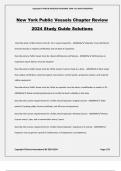Exam (elaborations)
New York Public Vessels Chapter Review 2024 Study Guide Solutions
New York Public Vessels Chapter Review
2024 Study Guide Solutions
Describe what a Public Vessel must do: For a vessel inspection - ANSWER-Operator must call Marine
Services Bureau to request certification and set date of inspection.
Describe what a Public Vessel must do: About deficiencies and ...
[Show more]
Preview 4 out of 33 pages
Uploaded on
November 11, 2024
Number of pages
33
Written in
2024/2025
Type
Exam (elaborations)
Contains
Questions & answers
Institution
Prep Tests
Course
Prep Tests
$12.49
100% satisfaction guarantee
Immediately available after payment
Both online and in PDF
No strings attached
Copyright © KAYLIN 2024/2025 ACADEMIC YEAR. ALL RIGHTS RESERVED




